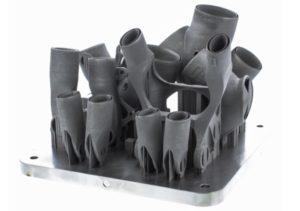![]() As someone who considers himself to be an avid cyclist, my calves get butterflies whenever I see or hear about 3D printing technology being utilized by a bicycle manufacturer. The effort has been undertaken on numerous occasions, assisted by some of the most prominent companies in the 3D printing industry. Back in February, Montague Bikes enlisted the help of Shapeways, which helped the bike company 3D print their foldable bicycle in aluminum material. Just prior to that, a group of Dutch students used MX3D’s metal 3D printing prowess to create a complex and unique bicycle of their own.
As someone who considers himself to be an avid cyclist, my calves get butterflies whenever I see or hear about 3D printing technology being utilized by a bicycle manufacturer. The effort has been undertaken on numerous occasions, assisted by some of the most prominent companies in the 3D printing industry. Back in February, Montague Bikes enlisted the help of Shapeways, which helped the bike company 3D print their foldable bicycle in aluminum material. Just prior to that, a group of Dutch students used MX3D’s metal 3D printing prowess to create a complex and unique bicycle of their own.
One of the most desired materials for bicycle manufacturing is carbon fiber, which is both lightweight and strong enough for some serious mountain biking. Carbon fiber mountain bike frames are traditionally casted from a mold, typically making custom-built carbon fiber frames a difficult endeavor. But the UK-based bike manufacturer Robot Bike Company has found a way to incorporate metal 3D printing with carbon fiber tubes, which has resulted in their R160 full-suspension mountain bike frame.
To make the R160, Robot Bike Company uses titanium 3D printing to procure lugs, which are a type of tubing mated with socket-like sleeves used to construct bike frames. These lugs are then used to join together the carbon fiber tubes, which are cut to the size of the rider’s measurements and bonded to the 3D printed titanium. According to the bike company, they use a type of Laser Powder Bed Fusion Additive Manufacturing technology similar to that used by aerospace companies like Airbus, Boeing, and GE. Not only does 3D printed titanium bond well with the carbon fiber tubes, it also provides adequate support to areas that will receive a heavy load.
The titanium powder, which is fused together by a high power fibre laser, is capable of reaching a resolution of between 10-45um. After printing, it’s heat treated for optimized mechanical performance, then CNC machined for bearing, headset, and bottom bracket fit. Robot Bike Company also utilizes topology optimization, an algorithmic approach to optimize material layout within a given space, which ensures that their bike frames are both lightweight and resistant to material fatigue. This computer-generative design approach is sourced from their partnership with Altair, a leading provider in topology optimization software.
The finished product is a mountain bike frame that weighs approximately 29 lbs and is uniquely fitted to each customer. Each R160 is specially manufactured according to measurements provided by the customer, as well as the type of riding they plan to undertake. The angle of these 3D printed lugs are equipped according to the dimensions and information provided by the rider, ensuring maximum comfort and stability.
The R160 (bike frame only) is currently available to order from Robot Bike Company for £4,395 (approximately $6,360), and takes about four weeks to manufacture and deliver after information is submitted and the purchase is made. By combining 3D printing technology and topology optimization together, the R160 is a cutting-edge mountain bike frame engineered to be as lightweight and mechanically stable as possible. Though I one day dream of being able to customize and 3D print a bicycle of my own, I’ll leave it to professionals like Robot Bike Company to pave the trail first. Discuss further in the 3D Printed Mountain Bike forum over at 3DPB.com.
Subscribe to Our Email Newsletter
Stay up-to-date on all the latest news from the 3D printing industry and receive information and offers from third party vendors.
You May Also Like
Nikon’s AM Expansion from California to Japan and Beyond: CEO Hamid Zarringhalam Weighs in
As we recently argued in a 3DPrint.com PRO article, Nikon Advanced Manufacturing has quickly gone from a prominent player in the metal additive manufacturing (AM) sector to become one of,...
The State of the Talent and Job Market in AM: 2025 Outlook
The additive manufacturing industry has seen significant shifts in recent years, with 2024 marking a critical turning point. Economic pressures, evolving hiring trends, and an increasing talent shortage at the...
SWISSto12 to 3D Print Antennas for SES’s Medium Earth Orbit Satellite Constellation
SWISSto12 has made a remarkable journey in satellite manufacturing. The company now produces its own HummingSat, as well as 3D-printed filters, waveguides, and other RF components. Recently, it was selected...
3DPOD 243: Volumetric 3D Printing with Xolo CCO, Stephan Kuehr
Stephan Kuehr began his career at 3YOURMIND before joining the volumetric 3D printing firm Xolo. In this episode of the 3DPOD, we discuss Xolo, its technology, volumetric 3D printing, bioprinting,...
































